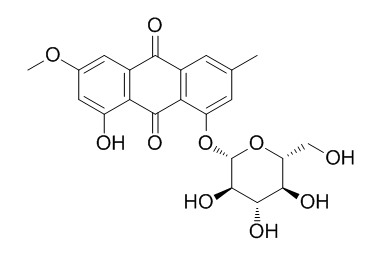Physcion 1-O-beta-D-glucoside
Physcion 1-O-beta-D-glucoside is a tumor cell growth inhibitor.
Inquire / Order:
manager@chemfaces.com
Technical Inquiries:
service@chemfaces.com
Tel:
+86-27-84237783
Fax:
+86-27-84254680
Address:
1 Building, No. 83, CheCheng Rd., Wuhan Economic and Technological Development Zone, Wuhan, Hubei 430056, PRC
Providing storage is as stated on the product vial and the vial is kept tightly sealed, the product can be stored for up to
24 months(2-8C).
Wherever possible, you should prepare and use solutions on the same day. However, if you need to make up stock solutions in advance, we recommend that you store the solution as aliquots in tightly sealed vials at -20C. Generally, these will be useable for up to two weeks. Before use, and prior to opening the vial we recommend that you allow your product to equilibrate to room temperature for at least 1 hour.
Need more advice on solubility, usage and handling? Please email to: service@chemfaces.com
The packaging of the product may have turned upside down during transportation, resulting in the natural compounds adhering to the neck or cap of the vial. take the vial out of its packaging and gently shake to let the compounds fall to the bottom of the vial. for liquid products, centrifuge at 200-500 RPM to gather the liquid at the bottom of the vial. try to avoid loss or contamination during handling.
Cell Mol Biol (Noisy-le-grand).2023, 69(15):167-173.
Horticulture Research2022, uhac276.
Mediators Inflamm.2016, 2016:7216912
J Pharm Pharmacol.2023, 75(9):1225-1236.
Chem Biol Interact.2018, 290:44-51
Int J Biol Sci.2023, 19(10):3077-3098.
Horticulture Research2023, uhad259
Biosci Rep.2018, 38(4)
Journal of Food and Drug Analysis2023, 31(3), 9.
Horticulturae2024, 10(4), 382.
Related and Featured Products
Life Sci. 1997;61(23):2335-44.
A tumor cell growth inhibitor from Polygonum hypoleucum Ohwi.[Pubmed:
9408056 ]
Polygonum hypoleucum Ohwi (P. hypoleucum Ohwi) has been used as a Chinese medicine for a long time. In the present study, four anthraquinones, emodin, emodin 1-O-beta-D-glucoside (49A), physcion (62A), and Physcion 1-O-beta-D-glucoside (50A) were identified from P. hypoleucum Ohwi and their inhibitory effects on various tumor cells proliferation were investigated. On a percentage basis, emodin had the highest suppressing activity on the various tumor cells proliferation.
METHODS AND RESULTS:
At 10 microg/ml, the percentage inhibition on K562 cells proliferation for emodin, 49A, 62A, and 50A were 97+/-3.4%, 18+7.3%, 24+/-3.6%, and 31+/-8.9%, respectively. However, inhibitory activities of 10 microg/ml of emodin, 49A, 62A, or 50A on Raji cells proliferation were 98+/-5.0%, 25+/-5.0%, 22+/-3.2%, and 28+/-4.3%, respectively. It was also found that the both C1 and C3 positions of emodin were important for antitumor action. The IC50s of emodin, 49A, 62A, and 50A on various tumor cells were also calculated. The IC50 of emodin on K562 cells was significantly lower than on Raji, HeLa, Calu-1, Wish, and Vero cells (1.5+/-0.2 vs. 2.8+/-0.4 microg/ml, P < 0.01 ;1.5+/-0.2 vs. 8.4+/-1.6 microg/ml; 1.5+/-0.2 vs. 8.9+/-1.0 microg/ml; 1.5+/-0.2 vs. 8.7+/-0.5 microg/ml; 1.5/-0.2 vs. 3.5+/-0.12 microg/ml; P < 0.001).
CONCLUSIONS:
The results indicated that K562 and Raji cells were more sensitive to emodin treatment. Cell viability test indicated that inhibitory effect of emodin on various tumor cell lines was not through direct cytotoxicity. It suggested P. hypoleucum Ohwi included a tumor cell growth inhibitor.
J Chem Ecol. 1992 Oct;18(10):1833-40.
Allelochemicals fromPolygonum sachalinense Fr. Schm. (Polygonaceae).[Pubmed:
24254724 ]
METHODS AND RESULTS:
The root exudates fromPolygonum sachalinense in a recirculating system significantly inhibited lettuce seedling growth. The rhizomes and roots ofP. sachalinense were extracted with 80% acetone. Bioassay of the neutral-acidic fraction on the TLC agar plate showed the inhibitory activity corresponded to the two yellow pigment bands. Two orange needles were isolated and identified as anthraquinone compounds: emodin and physcion. Both compounds exhibited inhibitory activities against the seedling growth of several testing plant species. Glucosides were isolated fromP. sachalinense and were identified as emodin-1-O-β-D-glucoside and
Physcion 1-O-beta-D-glucoside, respectively. On plant growth bioassay, these glucosides showed no phytotoxic activity against lettuce seedlings. The concentrations of emodin, physcion, and their glucosides from rhizome with roots, aerial parts, fallen leaves, and soil were determined. The rhizome with roots and fallen leaves contained emodin and physcion at relatively high concentrations. Emodin also occurs in the soil of this plant community with effective concentrations in the fall.
CONCLUSIONS:
The results indicate that these anthraquinones are responsible for the observed interference and are potent allelopathic substances.
Life Sci. 2001 Feb 2;68(11):1271-86.
Immune reponses in human mesangial cells regulated by emodin from Polygonum hypoleucum Ohwi.[Pubmed:
11233994 ]
In the hope of identifying agents of therapeutic value in glomerulonephritis from Chinese herbs, we found that methanolic extracts of Polygonum hypoleucum Ohwi (P. hypoleucum Ohwi) inhibit human mesangial cells proliferation activated with interleukin-1beta (IL-1beta) and interleukin-6 (IL-6) previously. This study was designed to identify bioactive components from P. hypoleucum Ohwi and elucidate their action mechanisms.
METHODS AND RESULTS:
We tested four anthraquinones emodin, emodin 1-O-beta-D-glucoside (49A), physcion (62A), and Physcion 1-O-beta-D-glucoside (50A) purified from P. hypoleucum Ohwi for their effects on human mesangial cell proliferation and cytokines production in vitro. On a percentage basis, emodin had the highest suppressing activity on the human mesangial cells proliferation activated by IL-1beta and IL-6. The IC50 of emodin on human mesangial cells proliferation were 17.9+/-1.2 microM. In contrast to 49A, 50A, and 62A, emodin also decreased IL-1beta, IL-6 and tumor necrosis factor-alpha (TNF-alpha) production in human mesangial cells activated with IL-1beta and IL-6. The IC50 of emodin on IL-1beta, IL-6 and TNF-alpha production in activated human mesangial cells were 16.6+/-1.8 microM, 8.2+/-1.3 microM, and 9.5+/-1.6 microM, respectively. Moreover, IL-1beta and TNF-alpha mRNA expression in activated human mesangial cells was impaired by emodin. The intracellular free Ca2+ concentration ([Ca2+]i) in IL-1beta and IL-6 activated human mesangial cells was decreased by emodin. It is unlikely that cytotoxicity was involved because no cell deaths were observable.
CONCLUSIONS:
We hypothesize that the inhibitory mechanisms of emodin on activated human mesangial cells proliferation may be related to the impairments of gene expression and production of cytokines and [Ca2+]i in the cells.



